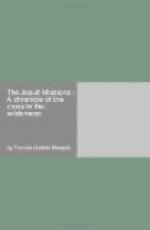The Jesuits were witnesses of this weird ceremony. They saw the naked Indians going about their task in the pit in the glare of torches, like veritable imps of hell. It was a discouraging scene. But a greater trial than the Feast of the Dead was in store for them. By a pestilence, a severe form of dysentery, Ihonatiria was almost denuded of its population. In consequence the priests, who had now been reinforced by the arrival of Fathers Francois Le Mercier, Pierre Pijart, Pierre Chastelain, Isaac Jogues, and Charles Garnier, had to seek a more populous centre as headquarters for their mission in Huronia. The chiefs of Oenrio invited the Jesuits to their village. But Brebeuf’s demands were heavy. They should believe in God; keep His commandments; abjure their faith in dreams; take one wife and be true to her; renounce their assemblies of debauchery; eat no human flesh; never give feasts to demons; and make a vow that if God would deliver them from the pest they would build a chapel to offer Him thanksgiving and praise. They were ready to make the vow regarding the chapel, but the other conditions were too severe—the pest was preferable. And so the Jesuits turned to Ossossane, where the people agreed to accept these conditions.
Formerly Ossossane had been situated on an elevated piece of ground on the shore of Nottawasaga Bay; but the village had been moved inland and, under the direction of the French, a rectangular wall of posts ten or twelve feet high had been built around it. At opposite angles of the wall two towers guarded the sides. A platform extended round the entire wall, from which the defenders could hurl stones on the heads of an attacking party, or could pour water to extinguish the blaze if an enemy succeeded in setting fire to the palisades.
Here the Jesuits were to live for two years. Outside the walls of the town a commodious cabin seventy feet long was built for them; and on June 5, 1637, in the part of the cabin consecrated as a chapel, Father Pijart celebrated Mass. The residence was named La Conception de Notre Dame. For a wilderness church it was a marvel. At the entrance were green boughs adorned with tinsel; pictures hung on the walls; crucifixes, vessels, and ornaments of shining metal ornamented the chapel. From far and near Indians flocked to see this wondrous edifice. Best of all, a leading chief offered himself for baptism. The future looked promising; the Indians showed the fathers ‘much affection’ and a rich harvest of souls seemed about to be garnered.
But all this was to be changed. A hunch-backed, ogre-like medicine-man who claimed to be of miraculous birth came to Ossossane. The pest was still raging, and he laid the blame for it at the door of the missionaries. According to him their prayers and litanies were charms and incantations; their pictures were evil okies. It was, he declared, by the influence of these and other agencies that they had spread the pestilence




